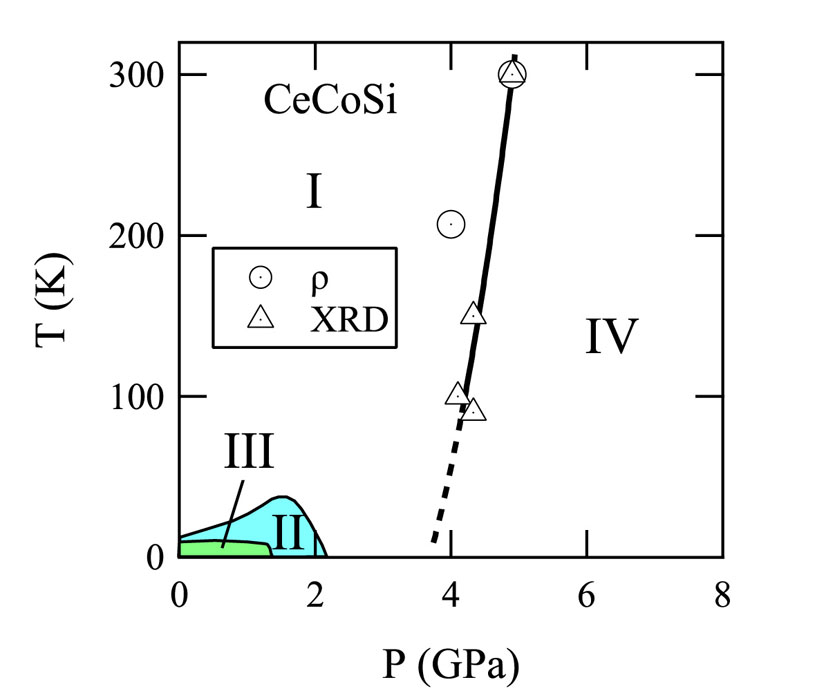Structural Instability and Electronic Properties of CeCoSi under Pressure
PI of Joint-use project: Y. Kawamura
Host lab: Uwatoko Group
Host lab: Uwatoko Group
We have clarified structural and electronic properties under pressure at low temperatures on CeCoSi, which has been attracted attention for its novel long-range order. CeCoSi crystallizes into the tetragonal crystal structure (No. 129, P4/nmm), which lacks local inversion symmetry at Ce site. CeCoSi exhibits a long-range ordering below T0 ~ 12 K at ambient pressure, which is proposed to be odd-parity multipole orderings. The T0 strongly enhances with increasing pressure and reaches 37 K at 1.7 GPa, followed by a rapid suppression. The phase below T0 is phase II and the phase II disappears above 2.2 GPa. CeCoSi also undergoes structural transition at Ps ~ 4.9 GPa at 300 K and becomes phase IV [1]. The rapid change of T0, followed by the emergence of phase IV indicates that Ce-4f electronic state significantly altered under pressure. In order to reveal the electronic and structural properties of CeCoSi in the above whole temperature and pressure range and to clarify the relationship between phase II and IV, electrical resistivity of CeCoSi in the pressure range of 0 ~ 8 GPa and in the temperature range of 2.5 ~ 300 K and X-ray diffraction in 0 ~ 6 GPa and in 6 ~ 300 K have been performed.
CeCoSi single crystals were grown with a Ce/Co eutectic flux method. The electrical resistivity on CeCoSi has been performed by cubic anvil pressure system with a standard four terminal method. X-ray diffraction (XRD) on powdered CeCoSi has been performed with GM refrigerator incorporated with diamond anvil pressure cell [2].
Figure 1 shows the phase diagram depicted based on the results of electrical resistivity and XRD under pressure. The anomaly of electrical resistivity is observed as drop of resistivity by the temperature or pressure, whereas additional peaks and peak splittings are observed in the XRD pattern. This study reveals that the boundary of phase IV and phase I is not directly connected to phase II or phase III.
The temperature dependence of resistivity exhibits a peak due to the Kondo scattering of the conduction electrons. The temperature of this peak rapidly increases with increasing pressure, which corresponds the rapid enhancement of Kondo temperature under pressure. Although CeCoSi is reported as localized electronic state at ambient pressure, the results of resistivity suggest that CeCoSi becomes itinerant electronic state around 2 GPa. XRD indicates that the ratio of lattice parameters c/a of CeCoSi linearly decreases with pressure up to ~ 4 GPa, which is just below Ps. In contrast, c/a of LaCoSi and PrCoSi decreases linearly below 2 GPa but they level off above 2 GPa. These results suggest that the valence of Ce on CeCoSi gradually increases from 3+ above 2 GPa. Also, the resistivity shows a drop to exhibit a metallic temperature dependence when crossing the phase IV.
These results strongly suggest that CeCoSi is localized character at ambient pressure and it gradually becomes itinerant character around 2 GPa and the valence of Ce gradually changes above 2 GPa. In addition, the Ce-4f electronic states changes drastically when crossing the boundary of phase I and IV, implying the valence change by the structural transition. Although phase II and IV is not directly influenced to each other, our results strongly suggest that both the rapid change of T0 and emergence of phase IV can be ascribed to the valence instability of Ce-4f electron.
References
- [1] Y. Kawamura et al., J. Phys. Soc. Jpn. 89, 054702 (2020).
- [2] Y. Kawamura et al., J. Phys. Soc. Jpn. 91, 064714 (2022).

